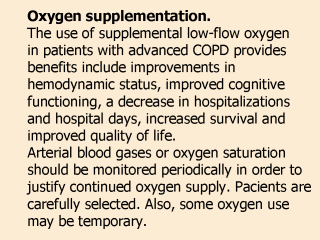 |
Continuous low-flow oxygen
therapy generally means greater than 18 hours per day. The mortality rate for subjects on
a 12-hour oxygen regimen could be nearly twice that of subjects on a 24-hour regimen.
According to some authorities, continuous low-flow oxygen therapy may add as much as 2
additional years of life.Oxygen
for long-term continuous low-flow therapy can be supplied to the home by compressed gas or
liquid. Oxygen can be administered via nasal prongs or through a transtracheal oxygen
(TTO) catheter. Transtracheal oxygen eliminates a large amount of dead airway space, thus
allowing for a reduction in the amount of oxygen used. TTO should be considered for
patients requiring 4–6 liters of oxygen per minute. Patients may be more comfortable
using TTO since it eliminates the need for oxygen tubing on the face. However, cleaning
the tubing requires training and some skill.
Patients with COPD may demonstrate worsening hypoxia
during sleep, because sleep causes hypoventilation, and patients with COPD may have
profound levels of hypoxia. Overnight monitoring of oxygen saturation may be indicated to
evaluate for nocturnal hypoxemia. |
